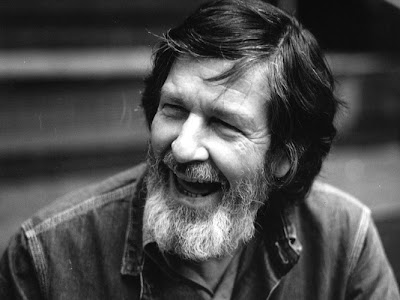
ジョン・ケージ氏が1952年に作曲した曲、4'33は、4分33秒にわたって、なんの楽器も演奏しない曲です。でもそれはただの無音なのでしょうか? ローレンス・フォスター指揮、BBC交響楽団よる演奏です。
演奏中、いったいどんな音が聴こえたでしょうか?
ときおり、ケージ・スマイルと呼ばれる笑顔を交えながら、静粛の中で聞こえる音について語っている映像です(耳コピ翻訳で字幕をつけました。動画をスタートして“cc”を押してみてください)。
リッスン (2004)より
When I hear what we call music, it seems to me that someone is talking. And talking about his feelings, or about his ideas of relationships. But when I hear traffic, the sound of traffic, here on 6th avenue for instance, I don't have the feeling that anyone is talking. I have the feeling that the sound is acting. And I love the activity of sound. What it does is it gets louder and quieter, and it gets higher and lower, and it gets longer and shorter… it does all these things which I'm completely satisfied with that. I don't need sound to talk to me.
我々が音楽って呼んでるものを聴いてると、まるで誰かが喋ってるみたいに感じてしまうんだ。気持ちとか、物事の関係についての見解とかね。でもトラフィック(人や物が行き交う様)を聴いてると、例えばここ六番街でも、音が喋っているような感覚はない。音が活動しているように感じるんだ。そして僕は音の活動が大好きなんだ。喧しくなったり、静かになったり、高くなったり、低くなったり、長くなったり、短くなったり、いろんなことをやって、それでまったく充分。僕は音に喋ってもらう必要なんかない。
We don't see much difference between time and space. We don't know where one begins and the other stops. So that most of the arts that we think of is being in time and most of the arts we think of is being in space. Marcel Duchamp for instance, began thinking of music as being not a time art but a space art. And he made a piece called “Sculpture musicale”, which means different sounds coming from different places, and lasting, producing a sculpture which is sonorous and which remains.
私たちは、時間と空間の違いをよくわかっていない。どちらがどこからはじまって、どこで終わるか知らないんだ。だから思いつくほとんどのアートは時間に存在しているし、思いつくほとんどのアートは空間に存在している。マルセル・デュシャンの場合は、音楽は時間芸術ではなく空間芸術だと考えるようになって、“Sculpture Musicale=音楽的彫刻”という作品をつくった。この作品が意図してるのは、いろんな音が、いろんな場所からやってきて、とどまって彫刻を形成し、深く共鳴して、残存するということなんだ。
People expect “listening” to be more than listening. And so sometimes they speak of “inner listening”, or the “meaning of sound”. When I talk about music, it finally comes to people's mind that I'm talking about sound that doesn't mean anything, that is not “inner” but is just “outer”. And they say those people who understand that finaly say : “you mean it's just sounds?”, thinking that for something to just be a sound is to be useless. Whereas I love sounds, just as they are. And I have no need for them to be anything more, than what they are. I don't want them to be psychological, I don't want a sound to pretend that it's a bucket, or that it's president, or that it's in love with another sound. I just want it to be a sound.
人は“音楽を聴くこと”が、単に聴くこと以上であることを期待している。だからときどき彼らは“内なる音”とか、“音の意味”なんて言い出したりするんだ。僕が音楽について語るとき、人々が僕が語っているのが無意味な音、“内なる”ではなく、“外なる”音について、だとようやく思い当たって、そして気づいた人はこう聞くんだ、“つまり、ただの音っていうこと?”って。ただの音なんてなんの役にも立たない、と考えながらね。一方、僕は音そのもの、そのままが好きなんだ。僕は音にそれ以上のものに、なってもらう必要なんてない。心理的になんてなってもらいたくないし、バケツになったり、大統領になったり、他の音と恋に落ちたりなんてしてほしくない(笑)。ただ音であってほしいんだ。
I'm not so stupid either. There was a German philosopher who is well known, Emmanuel Kant. And he said there are two things that don't have to mean anything : one is music and the other is laughter. Don't have to mean anything, that is in order to give us very deep pleasure. You know that, don't you?
僕がバカだからってわけじゃないよ。昔、イマヌエル・カントっていう有名なドイツの哲学者も、言っていたよ。意味が無くても良いものが、ふたつだけある:音楽と笑いだ、って。深い喜びを得るために、意味なんて必要なんてないんだよ。おまえは知ってるよねー(猫に)。
The sound experience which I prefer to all others, is the experience of silence. And silence almost everywhere in the world now is traffic.
音の経験のなかで、いちばん好きなのは、静粛の経験なんだ。そして静粛にすると、今は世界中ほとんどどこでも、トラフィックの音が聴こえる。
If you listen to Bethoven or Mozart, you see they are always the same. But if you listen to traffic, you see it's always different.
ベートーヴェンやモーツァルトを聴くと、いつでも同じでしょう。でもトラフィックの音は、いつも違っているんだ。
注: トラフィック=交通、とは限らず、ジョン・ケージ氏の真意が不明だったので、元のワードのままにしてあります。人やモノ、情報やお金も、行き交えば“トラフィック”と表現できるので。
4'33は、聴くたびに違った演奏者が現れ、違った“音楽”が流れます。世界には、思っているより多くの音があふれているようです。
Photo: John Cage Trust
In the dark, all cats are black
暗闇では、どんな猫も真っ黒だよ
~John Cage










